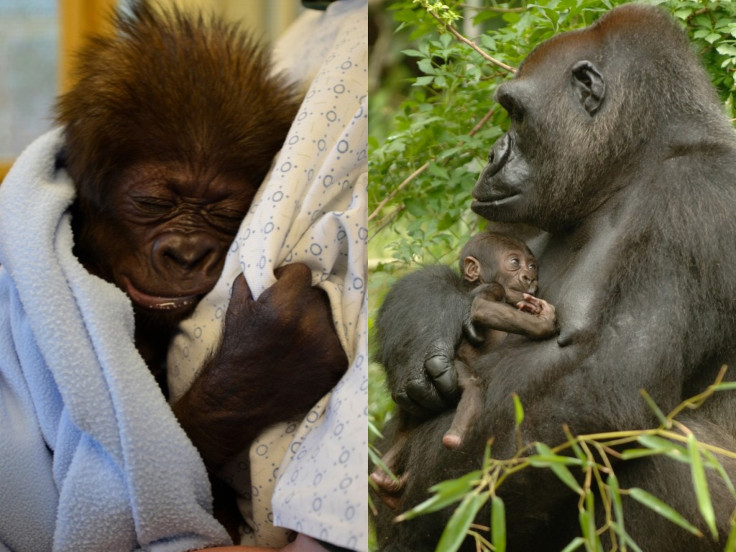Gladys Gorilla Being Raised By Human Surrogates At Cincinnati Zoo [VIDEO]

They say it takes a village to raise a child; at the Cincinnati Zoo, it takes exactly 10 adults to raise one abandoned baby gorilla.
Common to most first-time gorilla mothers, Gladys Stone was rejected by her 14-year-old mother “Kiazi” after being born at Gladys Porter Zoo in Brownsville, Texas, in January. The Cincinnati Zoo team of 10 primate experts are now acting as surrogate parents to the infant, reported ABC News Thursday.
The team is not only responsible for caring for the 2-month-old, but also going as far as wearing fur vests and jackets and mimicking primate behaviors such as knuckle-walking and making grunting noises to properly prepare the animal for an adult life with the other zoo primates.
In an effort to make Gladys transition to the human touch a little less drastic, the zoo partnered with a local company, Fabulous-Furs, to fashion fur vests and coats for the animal keepers to wear while caring for the infant.
President of Fabulous-Furs Donna Salyers, said helping animals is the “heart” of her business.
"…Believing one of our fabrics might help make baby Gladys’ life easier made helping an easy decision. Now, as we share Gladys’s story with our kids and grandkids, their enthusiasm makes it even more meaningful. We’re absolutely thrilled to contribute,” said Salyvers in a press release from the zoo released earlier this month.
Leader of the Primate Team at the Cincinnati Zoo, Ron Evans, said the suits play an integral role in the day-to-day care of Gladys.
“The day a baby gorilla is born they can pretty much hold on to mom without any support. So we need to give Gladys the same opportunity as we’re doing her surrogacy ourselves until she goes in with a gorilla,” said Evans. “We are extremely grateful to Donna Salyers and her entire team.”
The primate was named after the owners of the Texas zoo, the Stone family, in an effort to honor them after Gladys was transferred by the family to the zoo for surrogate care. Evans said the families around-the-clock care was her reason for her survival during her first few weeks of life.
“[They] deserve all the recognition in the world for how quickly they swooped in and rescued Gladys…It was hard for them to see her go, and took a lot of love for them to say goodbye, and we wanted to acknowledge that,” said Evans.
Gladys may seem sweet at her current small stature, but Evans said taking care of the infant is a 24/7 repsonsibility.
“Whatever a gorilla mom would do with her baby is what we have to do with this baby,” he said. “The role of the human surrogate mother is critical for the development of this baby. Surrogates must do their very best to teach her the ways of the world, including what behavior is acceptable, what her routines will be when she is with her gorilla family and what is safe."
Despite the large demands of caring for one animal, Thayne Maynard, executive director of the Cincinnati Zoo, said he is honored to be involved with the historical first gorilla surrogacy ever attempted.
“This will certainly be a labor of love ... This is such a huge responsibility and privilege and we are honored to be doing our part,” Maynard said.
The surrogacy is estimated to last until Gladys is 7 months old, at which point she will most likely go into the care of one of the zoo’s two female gorillas, 43-year-old “Samantha” or 30-year-old “M’Linzi.”
© Copyright IBTimes 2024. All rights reserved.






















